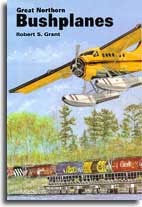"Chevy Pickups of the Air"
![]()
Cessna
"Adaptable, Agile and Seldom Stuck"
Writers often overlook the Cessna utility line
while researching radial engine wonders like Norsemen and Beavers. They
ignore the fact that countless, inexperienced pilots with fresh commercial
licenses began their careers in these diminutive airplanes. Battered by
windstorms, smashed into cement-like ice ridges and overturned on glassy
water lakes, Cessnas worked unnoticed and efficient.
"They have their place in the north all
right," Gangloff said. "You talk to air services like Green
Airways, Sabourin, Big Trout Lake and Bearskin… and ask them what they
started with."
Cessna Aircraft Company of Wichita, Kansas
probably took little notice of markets in faraway Canada when they
delivered their first Model 180 in February, 1953. Nothing more than a
redesigned, oversize Cessna 170, it became an instant hit throughout the
United States. With a six-cylinder, 225-h.p. horizontally opposed
Continental piston engine, the "Wichita Wonder," as operators
called it, had no competition.
In April, 1953, Cessna claimed their
"greatest low cost floatplane" needed an 1,830 ft. water run to
lift a gross weight of 2,700 lbs. "Para-lift" flaps, a 500 lb
cargo capacity, yard-wide doors and a $12,950 price tag offered what
Canadian Aviation magazine called a "...fresh, promising solution to
the problems of Canadian bush flying..."
When production ended in 1981, 6,193 were sold.
Originally offered to business travelers, Cessnas carried far more than
attaché cases. The distinctive aromas of fish slime, sweaty bottoms and
gasoline-soaked interiors became standard as users accepted them in every
comer of backwoods Canada.
"Legally, I don't think you could haul 600
lbs in a 180 with full fuel but we'd always take three guys and gear with
full tanks and go north, no trouble at all," he said. "Three
feet of floats under the water, she'd still go..." added one
experienced bush pilot.
In 1961, Cessna applied new ribs, redesigned
stringer patterns and stronger wing spars to the Model 180 airframe to
produce the "Cessna 185 Skywagon." They included a 260-h.p.
Continental engine and expected the upgraded Cessna to replace hundreds of
overworked Model 180s. With floats, the 185 legally flew 1,125 miles. One
magazine quoted an empty weight on wheels of 1,520 lbs and maximum takeoff
weight of 3,200 lbs - 600 lbs more than a Cessna 180. With long-range
gasoline tanks filled, payload reached 996 lbs.
Tail wheel Cessnas turned out to be tricky to
handle with the 3/4-in. chrome vanadium steel landing gear. Men of
experience, said writer James Sharp, believed only two kinds of Cessnas
existed: those that have ground looped and those that will. With long
fuselages and billboard-size tails, crosswinds on paved runways could
never be taken casually. Veterans with thousands of hours on type
sometimes lost control.
"If you put the Cessna 185 or Cessna 180
down too early with too much speed or sink, the gear acts just like a
spring to bounce you back into the air," said one pilot. "Once
that bounce came, you don't got no choice but to hold that control wheel
all the way back or else slam the power on and go around again..."
Most pilots preferred landing on the two main
wheels first and letting the tail settle as airspeed dropped. On slippery
or gravel surface airstrips, touching down without the nose centered
mattered little since a slight slide did no harm. Some pilots dreaded
paved runways especially after winters of easy ski flying. On landing, the
airplane "grabbed" sharply and bounded away in the direction of
the nose. Such an incident embarrassed Jane Etzkorn at Brochet, 235 miles
north of The Pas, Manitoba.
"When I touched, my 185 just darted off the
strip and the three guys riding with me screamed," she laughed.
"I managed to get the thing back in one piece and thought, 'Oh, my
God, Indian people never say anything and I made them scream.' It had to
be the absolute worst landing in the world." 1
Most "bush-tuned" Cessnas
spent their working careers on floats. Although float brands such as Edo,
Wipline, Aqua and several others crowded the market, the Edo 2870…
became the most popular. Later, Canadian Aircraft Products… proved
satisfactory, if not differing in required take off techniques.
"The 185 1 flew out of Watson Lake had CAP
3000s which people thought were a lot harder to fly," said Gerry
Norberg. "Instead of hauling back and yanking back and forth to get
off the water, you'd just leave the thing neutral with two notches of flap
and let it climb out of the lake on its own."
Another pilot found the CAPs "scary"
until he logged several hundred hours on them. He claimed they had a
"fairly short spot" or fine balance point between less drag and
more lift. On landings, the CAPs tended to snub the front ends and
demanded more concentration than Edos or Wiplines. In late fall, pilots
dreaded flying CAP-equipped Cessnas because of the rounded float tops.
Many unwary souls overlooked a frozen skim of ice on the metal float and
plunged into an October lake…
"I'd just as soon do without them but there
are times when you don't want a Beaver," said Vancouver Island Air's
Larry Langford. "It's cheaper for us to fly the 180 and at least it's
got a bulletproof carburetted engine."
By "bulletproof," Langford meant that
Cessna 180 engines pose few mechanical problems. He preferred them instead
of the more powerful Cessna 185s for his routine two-passenger loads. Much
of Vancouver Island Air's work deals with quick trips to Seattle,
Washington, or pleasure flights with pairs of whale-watching, hand-holding
honeymooners. The Cessna 185 could easily do the same task but expenses
accelerate.
"On short hauls, you go out and buy new
cylinders for a 185 about every 700 hours and when you're paying $1,000 a
jug and it seems like every second inspection one gets replaced, then you
look at the economics," Langford said.
Cessna 185s lack carburetors. Instead, gasoline
is injected directly into the cylinders through a series of nozzles. At
first, the concept sounded practical but the complex pumps, fuel return
lines and header tanks often delayed engine starts. On seaplanes, misfires
sometimes led to unplanned scenic tours down sharp-rock rapids.
Norman Biegler, a Vancouver Island Air pilot,
stressed that fuel-injected engines were susceptible to poor warm-weather
starting. They sometimes developed vapor lock in the lines after shutdown.
To start, these lines needed purging by what one mechanic called a
"fair amount of cranking," often to the point of a dead battery.
Rochelle Bodnar worked briefly for a West Coast organization which owned
Cessna 185 C-GWNS. Company staff derisively called it Will-Not-Start to
match the last three letters of the registration. Pilots dealing with
holidaying Chicago cops who have just spent days on hot highways only to
be told their fishing flight is delayed, rarely appreciate vapor lock.
"Fuel-injected engines seem to be more
susceptible to thermal heating and cooling so they start cracking from the
spark plug to the exhaust valve," said Langford. "Carburetors
can pass rust or dirt right through, but the same stuff plugs a fuel
injector nozzle..."
"When you had a hot day, that thing (Cessna
185) was a real bugger. You'd push off from a dock and crank and crank and
crank and nothing happens," said an operations manager at Goose Bay,
Labrador. "In the air, those Cessnas had hot-running engines so it
took time to familiarize new guys with cowl flaps and how to cool an
engine." 2
Veteran Larry Morden of Landseaair in
Red Lake pointed out that Cessnas could be intimidating to newly trained
commercial pilots. Awed by 230-h.p. bushplanes instead of 100-h.p.
trainers, they neglected to remember that they had to fly the airplane and
not the engine. In other words, Morden explained, it mattered little what
was under the hood; all airplanes had limitations, especially tired bush
workhorses.
Heavy-load takeoffs required the light hand of
finesse, Morden said. In 185s, most pilots used one notch or
"click" on the thumb release ratchet flap handle between the
front seats. After blasting themselves onto the step, some added another
notch (i.e., twenty degrees) and accelerated. Next, they slammed down
another ten degrees to jump into the air. Not everyone agreed.
"Me, I use full power, drop ten degrees of
flap, get on the step and just lay back and wait," said Herb Neufeld.
"Add another notch, then off with one float, hold the handle and ease
off slow on that last ten degrees after she's flying."
Coastal pilots learned quickly when they
encountered ocean swells. Rolling one float out of the water may help them
shorten the takeoff but sometimes, said a Harbour Air veteran in
Vancouver, they play a waiting game. In light winds, aligning parallel
with the swell pattern is safer than crashing into them head on. Shaking
the airframe into a motionless blur should be avoided whenever possible.
"We go through a lot of windshield V-braces
and take a real beating with our 185s," said Trevor Bird of Harbour
Air. "If you stay right in the swells, you'll be okay and sometimes
you have to ride up and down the first couple to get some speed."
One pilot north of Geraldton admitted complacency
nearly got him into serious trouble. After pushing in full throttle, he
placed his Cessna 185 onto the step when a severe wind gust struck the
airplane and spun it almost completely around. No damage occurred but this
pilot unwillingly earned the distinction of becoming one of the first
pilots to "water loop" a floatplane…
Seaplane landings on towering ocean waves are
frightening to "flatlanders," a term referring to pilots who
learned to fly east of the Rocky Mountains. To reduce the impact of solid
swells, pilots prefer transitioning from graceful flight to taxi speed
with a nose high, flap on, slow-as-possible approach. Sometimes, nothing
helps.
"You're just going to pound. Once you hit
that water, forget the control column, you can't hardly hold it,"
said one pilot.
Flight instructor Dave Hamel of Fort Langley
Aviation, 19 miles southeast of Vancouver, spent hundreds of hours
familiarizing students with Cessna 180 ocean flying. He pointed out that
swells occur regardless of wind condition and, from above, look
deceptively smooth. Avoiding airframe damage is not impossible, Hamel
said, but pilots must understand different shoreline types and water
surfaces. Anyone-old pro or novice-can be fooled.
"A guy comes over a bay and says, 'Ah,
great, that looks like a nice beach.' So they come on down to what they
think is calm water and Wham! They wonder why the skin wrinkled,"
said Hamel…3
Cessna 180s, said Bert Archer, can be
notorious "diggers." Assigned to familiarize an employee with
his company's routes, he decided to do the trip without a control wheel on
his side. The new man would do the flying.
"So this guy's getting ready to land and I
says, 'Better slow down, you're like a house on fire.' He says,
"What?" So I told him again, 'Slow the damn thing down.' Just
then he hits at about 120 mph I reached over and pulled the wheel back and
hit the throttle. She skipped two or three times on the front of the
floats and Jesus, we got the hell out of there…"
Since the first Cessna entered the northern
scene, this high wing utility line has improved. More powerful engines,
modified wings and various landing gears have been tried and nearly all
worked well.
"By God, you gotta admit," said a
slightly bushed diesel mechanic waiting for a ride to Thompson…from 217
miles northwest of Churchill, "them little Cessnas can do just about
anything you want them to and you'll get away with it, don't matter
what."
He spoke the truth.
Cessnas have served as backbones for many
northern entrepreneurs and as starter airplanes for hundreds of junior
pilots. Like the Douglas DC-3, Noorduyn Norseman and other greats, the
Cessnas are, as aviation writer William Cox wrote in Plane & Pilot
June 1983, "Utterly timeless."
The words of John McElwain, however, describe
best what kind of punishment a Cessna can absorb. Flying in late one
evening in poor visibility he mused to himself, "almost home… and
it's Miller time." In that instant, John thought he was going to die.
"There was a bright blue flash off to the
right as I was slammed into my shoulder straps. One of the rear seats
sailed past my head and wiped the magnetic compass out and bounced
back," he said. "I felt the airplane falling and I shoved the
throttle and prop to the wall as my left hand pushed the control column to
the stops and then pulled it back to my belt buckle.
"I couldn't see a thing and it was, oh, so
dark, and I held the nose up, waited and smash, we were on the water.
Afloat. Alive."
McElwain's propeller had severed one of four
thick electrical lines and dragged the remaining three to the water.
Accident investigators concluded he could not have seen the unmarked
wires. McElwain said, "No matter how bad things look, keep flying the
airplane. It's not over 'til it's over."
![]()
Note from the Editor. I would like to thank Robert S. Grant for bringing us this well researched book on the great bush planes of the north. This selection was taken out of Chapter 9 from his book Great Northern Bushplanes. The chapter was edited and abridged to better fit this page. To contact Robert email him directly at rgrant@vianet.on.ca

Cessna 185. They are not just in the north,
but can be found working all over the world.
Dave's Bush Pilot Tip! If you planning to take a job flying a Cessna up north there are several questions you should ask. 1 What happened to the previous pilot? 2 What happened to the previous engine? 3 Why is the sheet metal man coming up on the same flight? See the reference numbers above for the answers. On second thought: Don't Ask!
The attitude indicator will take you back to Feature Stories.
Last modified on
March 06, 2006
.
(c) Virtual Horizons, 1996.





